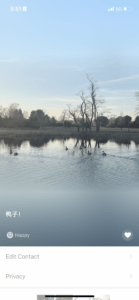How does application design harm?
As the documentary reflected, social media applications have caused distraction and toxic addiction among users, leading to an enormous waste of time. One example I experienced recently was WeChat. I noticed several application designs and user experiences that attract our attention without us consciously realizing it.

-
- The notification function on the top left corner that appears on the application icon constantly reminds consumers to automatically reopen the application every time they open their phones. The banner notifications, which also come with sound notification or vibration, also attract users visually, tactually, and acoustically to pick up their phones and fall into the pitfall of endlessly swiping through short videos, WeChat moments, or chats. When I was doing my homework, if I put my phone, which is not turned on to Focus mode, on my desk, it would always attract my attention when it vibrates. I know I should focus on my work, but the notifications always raise my sense of curiosity and expectation to the linkage with people.
- The immersive user experience with the fullscreen display of videos in the WeChat Channel section amplifies the short-term pleasure that brings to the users, pulling users deeper into the desires of watching more and more videos.
- The design of simple user interaction of swiping up across the screen in the Channel section adds in the likelihood of longer time spent in watching videos because the actions become habitualized, unawared, and unconscious.
- Since the WeChat Channel section provides a platform with an infinite number of videos – there is no ending to the simple movement of thumb swiping across the screen. Knowing this feature, users’ expectation for a similarly desirable experience of pleasure is triggered after watching the previous video, leading them to swipe for the next. This mentality continues infinitely, causing more severe addictions.
- We receive positive intermittent reinforcement while we do not know what we are going to watch next, but the database precisely calculates our preferences and provides us with content that they think we are more interested in, exactly fulfilling our expectations and demands for the short-term pleasure.
- The addiction is further brought to us through giving expectations in the Message section in WeChat as well. The application interface would visualize the “typing” state of the other user. While we are waiting for the reply, we are very likely to go into other sections in WeChat such as subscriptions, moments, or channels, which prolong the time and attention we spent on the application.
How does application design help?
I think application, especially social media, has immensely optimized the online connection with people, fulfilling users’ natural desires of human interaction and wishing to share even when they are physically alone. Furthermore, it also allows us to easily construct a visual, tangible identity package through a personal profile, moment posts, etc. The ability to efficiently gain knowledge of a person’s identity helps the linkage with friends in an online context. Besides the basic functions of sending messages, I think WeChat developed functions that successfully achieve this goal this the status function, allowing us to share our current emotional state.
- Unlike WeChat moment posts, which are permanently a representation of our identity if we do not set any restriction of views, status setup only lasts 24 hours. The temporary share of status provides variations in choices, fulfilling different types of sharing desires and expression needs. The dynamics of functions bring the dynamics of online identity construction.

Status icon next to name - The status icon is designed to place next to the user name. The position is very visible and easy to access than clicking into the moment section.



- The background of the user profile will automatically turn into status content when the status is set. If we scroll down the screen of our friends’ profiles, the interface would show the status content in fullscreen or almost fullscreen, creating an immersive, intimate experience while creating this linkage with the friend.
- Users can view friends who share the same status. On one hand, users have another pathway to build connections with friends; On the other hand, shared emotional status forms the sense of empathy, pulling the connections with the friends closer. The distance can be even closer with the integration of the “like” button.
